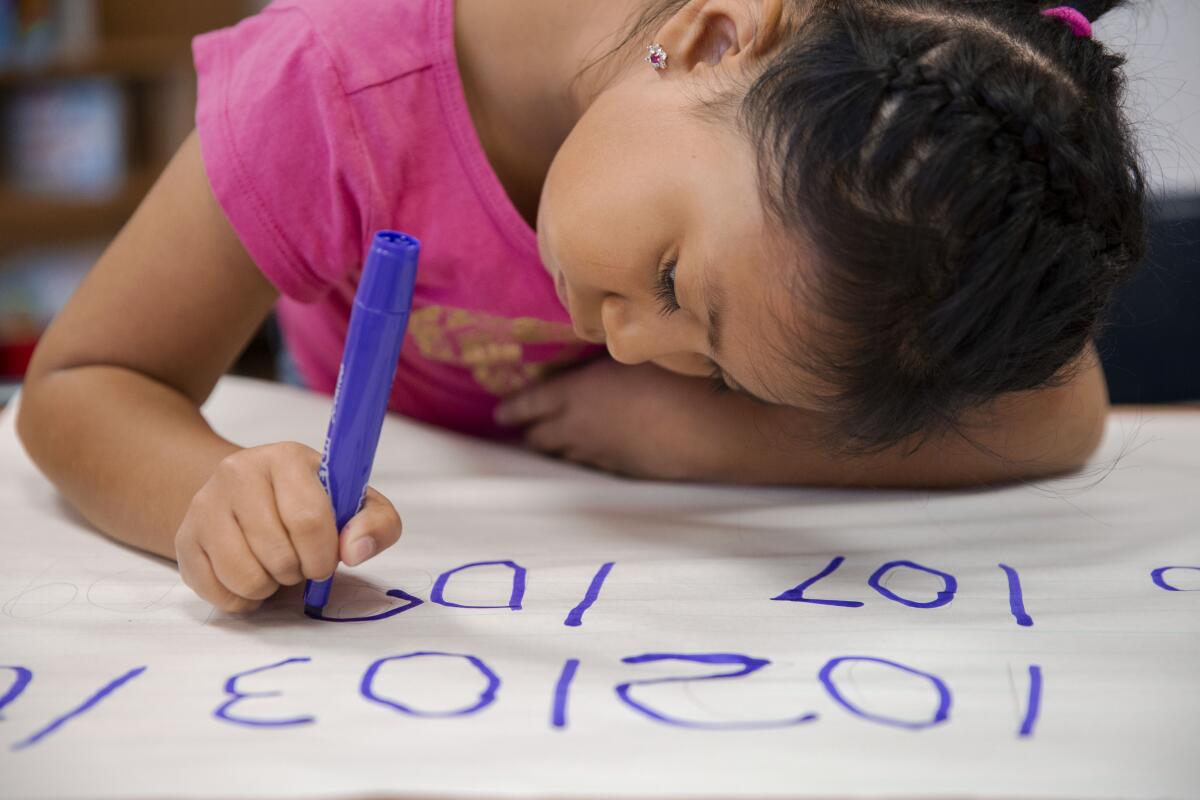Editorial: Adding up California’s new-new-newest math

- Share via
Contrary to the ill-informed criticisms that are circulating, a new mathematics proposal for California schools would not take the rigor — or the emphasis on finding correct answers — out of math. It would almost certainly make math more interesting to a lot of students. And it would get rid of the crazy requirement, adopted in 2008, that all students take algebra in eighth grade. It is important for students to understand one level of math well before moving to the next, and not all kids reach the same level of understanding in lockstep.
The problem is that the newest math would impose its own kind of lockstep, by requiring students who grasp math quickly to remain in the same classes as everyone else through sophomore year of high school. Under the current system, some students start moving ahead more rapidly in middle school. That academic tracking often leaves out talented Black and Latino students, but the goal should be to take the racism out of tracking rather than try to force all students into the same mold.
The state’s draft mathematics framework, which is undergoing some revision and will be considered by the state Board of Education next fall, would do away with the traditional algebra–geometry–algebra 2 sequence of courses, frequently followed by trigonometry and calculus, in favor of an integrated approach. In other words, students might use various branches of mathematics as well as arithmetic and real-life research to figure out, for example, how to revegetate a wilderness area with native plants, along with cost calculations.
It’s far more engaging than traditional math classes. And, at least theoretically, it works for different levels of students. A skill is just a skill, more quickly learned by some than others. But applying those skills to challenging real-world projects demands creativity and critical thinking.
There’s no getting around the truth underlying the proposed new framework, though: Its roots lie in the yawning race- and poverty-based gaps in math achievement. It is, in a way, an admission of failure. Not only has the education system failed to prepare all students for eighth-grade algebra, it has failed to bring the students who most needed help to the point where they had anything like an equal chance at taking advanced courses or being prepared for a four-year college. In 2018, the state reported that just under 20% of Black students met math standards, while more than half of white students and nearly three-fourths of Asian students did. Overall, California’s students are not doing nearly as well in math as they should be.
In places, the math framework itself reads almost as much like a social equity document as one on mathematics, asserting that “All students deserve powerful mathematics; we reject ideas of natural gifts and talents.” All students do deserve strong mathematics education, along with the assumption that when they are engaged, most of them can master advanced math. They deserve classes that meet them at their level and challenge them to grow from there.
But that also should mean allowing gifted students to advance as rapidly as they can and want to advance. Whether their gifts are called natural or not, some students — without special tutoring, without especially ambitious parents — learn math at top speed. Most students have the ability to learn higher math skills, but some of them learn it seemingly effortlessly.
The framework’s idea of how to deal with this is for more adept students to be in the same classes as everyone else, but given more challenging projects to work on. That could be nice in theory. But in practice, this kind of “differentiated instruction” is hard to pull off as teachers try to track the progress of students who are all over the achievement map. Is the state willing to invest the money needed to drastically reduce the size of math classes and make the new approach work as intended? Unlikely.
It would be no more fair to hold high-octane math students behind than it has been to force unready students into eighth-grade algebra classes. There should be room for both kinds of math education — and there might well be, since school districts wouldn’t have to follow the framework and many parents would object to the change.
In ways, the new guidelines might open a new era of intriguing mathematics education that inspires the students who were given too little opportunity to show that they, too, had “math brains.” But to the extent that the framework would rein in talented students who are ready to rev forward, it could be the catalyst that prompts many families to flee the traditional public school system and seek out charter and private options. That’s not the sign of a successful new math.
More to Read
A cure for the common opinion
Get thought-provoking perspectives with our weekly newsletter.
You may occasionally receive promotional content from the Los Angeles Times.










